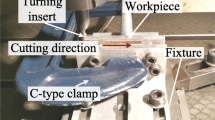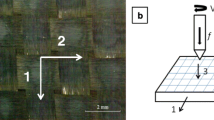Abstract
Drilling of carbon fiber-reinforced polymer (CFRP) is one indispensable machining operation to produce holes for final assembly of structural parts. Excessive cutting forces during drilling processes will lead to machining defects, such as fiber breakage, burrs, micro cracks, and plies delamination within laminate. This paper aims to simulate the variation of instantaneous cutting forces in CFRP drilling considering the influences of fiber orientation, machining parameters, and tool geometries. The cutting edges are split into infinitesimal elements; the instantaneous cutting forces are obtained by the accumulation of elemental forces exerted on all engaged elements. The overall cutting forces are the combination of forces contributed by the cutting lips and chisel edge using different machining mechanisms; oblique cutting and mechanistic modeling approaches are applied to the cutting lips while the principle of contact mechanics is adopted for the chisel edge. An integrated artificial neural network (ANN) and genetic algorithm (GA), ANN-GA is developed especially for predicting the specific cutting force coefficients, which are functions of the fiber orientation and can account for the variation of cutting forces. Meanwhile, the change of geometrical parameters along the cutting lips is analyzed, and the effects of fiber orientation and tool geometries are integrated in the model. Results showed the proposed model is able to predict the instantaneous cutting forces in CFPR drilling. Model predictions agree well with experimental data and are beneficial for optimizing the machining processes of CFRP composite laminates.
Similar content being viewed by others
References
Xu J, Mansori ME (2016) Experimental study on drilling mechanisms and strategies of hybrid CFRP/Ti stacks. Compos Struct 157:461–482
Zenia S, Ayed LB, Nouari M, Delamézière A (2015) Numerical analysis of the interaction between the cutting forces, induced cutting damage, and machining parameters of CFRP composites. Int J Adv Manuf Technol 78(1-4):465–480
Rahmé P, Landon Y, Lachaud F, Piquet R, Lagarrigue P (2011) Analytical models of composite material drilling. Int J Adv Manuf Technol 52(5-8):609–617
Tsao CC (2012) Evaluation of the drilling-induced delamination of compound core-special drills using response surface methodology based on the Taguchi method. Int J Adv Manuf Technol 62(1-4):241–247
Iliescu D, Gehin D, Gutierrez ME, Girot F (2010) Modeling and tool wear in drilling of CFRP. Int J Mach Tools Manuf 50(2):204–213
Chen WC (1997) Some experimental investigations in the drilling of carbon fiber-reinforced plastic (CFRP) composite laminates. Int J Mach Tools Manuf 37(8):1097–1108
Girot F, Dau F, Gutiérrez-Orrantia ME (2017) New analytical model for delamination of CFRP during drilling. J Mater Process Technol 240:332–343
Hocheng H, Tsao CC (2005) The path towards delamination-free drilling of composite materials. J Mater Process Technol 167(2-3):251–264
Lazar MB, Xirouchakis P (2011) Experimental analysis of drilling fiber reinforced composites. Int J Mach Tools Manuf 51(12):937–946
Ameur MF, Habak M, Kenane M, Aouici H, Cheikh M (2016) Machinability analysis of dry drilling of carbon/epoxy composites: cases of exit delamination and cylindricity error. Int J Adv Manuf Technol 88(9-12):1–15
Stephenson DA, Agapiou JS (1992) Calculation of main cutting edge forces and torque for drills with arbitrary point and geometries. Int J Mach Tools Manuf 32(4):521–538
Su Y, Jia Z, Niu B, Bi G (2017) Size effect of depth of cut on chip formation mechanism in machining of CFRP. Compos Struct 164:316–327
Qi Z, Zhang K, Cheng H, Wang D, Meng Q (2015) Microscopic mechanism based force prediction in orthogonal cutting of unidirectional CFRP. Int J Adv Manuf Technol 79(5-8):1209–1219
Langella A, Nele L, Maio A (2005) A torque and thrust prediction model for drilling of composite materials. Compos Part A-Appl S 36(1):83–93
Meng Q, Zhang K, Cheng H, Liu S, Jiang S (2015) An analytical method for predicting the fluctuation of thrust force during drilling of unidirectional carbon fiber reinforced plastics. J Compos Mater 49(6):699–711
Chandrasekharan V, Kapoor SG, Devor RE (1995) A mechanistic approach to predicting the cutting forces in drilling: with application to fiber-reinforced composite materials. J Eng Ind-Trans ASME l17(4):559–570
Guo DM, Wen Q, Gao H, Bao YJ (2011) Prediction of the cutting forces generated in the drilling of carbon-fibre-reinforced plastic composites using a twist drill. P I Mech Eng B-J Eng 226(1):28–42
Karpat Y, Bahtiyar O, Değer B, Kaftanoğlu B (2014) A mechanistic approach to investigate drilling of UD-CFRP laminates with PCD drills. CIRP Ann-Manuf Technol 63(1):81–84
Li H, Qin X, He G, Jin Y, Sun D, Price M (2016) Investigation of chip formation and fracture toughness in orthogonal cutting of UD-CFRP. Int J Adv Manuf Technol 82(5-8):1079–1088
Chen L, Zhang K, Cheng H, Qi Z, Meng Q (2016) A cutting force predicting model in orthogonal machining of unidirectional CFRP for entire range of fiber orientation. Int J Adv Manuf Technol 89(1-4):1–14
Jahromi AS, Bahr B (2010) An analytical method for predicting cutting forces in orthogonal machining of unidirectional composites. Compos Sci Technol 70(16):2290–2297
Zhang LC, Zhang HJ, Wang XM (2001) A force prediction model for cutting unidirectional fiber-reinforced plastics. Mach Sci Technol 5(3):293–305
Wang XM, Zhang LC (2003) An experimental investigation into the orthogonal cutting of unidirectional fibre reinforced plastics. Int J Mach Tools Manuf 43(10):1015–1022
Li H, Qin X, He G, Price MA, Jin Y, Sun D (2017) An energy based force prediction method for UD-CFRP orthogonal machining. Compos Struct 159:34–43
Altintas Y (2012) Manufacturing automation: metal cutting mechanics, machine tool vibrations, and CNC design. Cambridge University Press, Cambridge
Lin GCI, Mathew P, Oxley PLB, Watson AR (1982) Predicting cutting forces for oblique machining conditions. P I Mech Eng 196(1):141–148
Kalla D, Sheikh-Ahmad J, Twomey J (2010) Prediction of cutting forces in helical end milling fiber reinforced polymers. Int J Mach Tools Manuf 50(10):882–891
Shetty N, Herbert MA, Shetty R, Shetty DS, Vijay GS (2016) Soft computing techniques during drilling of bi-directional carbon fiber reinforced composite. Appl Soft Comput 41:466–478
Prasanth ISNVR, Ravishankar DV, Hussain MM, Badiganti CM, Sharma VK, Pathak S (2017) Investigations on performance characteristics of GFRP composites in milling. Int J Adv Manuf Technol 99(5-8):1351–1360
Danish M, Ginta TL, Habib K, Carou D, Rani AMA, Saha BB (2017) Thermal analysis during turning of AZ31 magnesium alloy under dry and cryogenic conditions. Int J Adv Manuf Technol 91(5-8):1–14
Karnik SR, Gaitonde VN, Rubio JC, Correia AE, Abrão AM, Davim JP (2008) Delamination analysis in high speed drilling of carbon fiber reinforced plastics (CFRP) using artificial neural network model. Mater Des 29(9):1768–1776
Wang DH, Ramulu M, Arola D (1995) Orthogonal cutting mechanisms of graphite/epoxy composite. Part II: multi-directional laminate. Int J Mach Tools Manuf 35(12):1639–1648
Ramulu M, Kim D, Choi G (2003) Frequency analysis and characterization in orthogonal cutting of glass fiber reinforced composites. Compos Part A-Appl S 34(10):949–962
Karpat Y, Bahtiyar O, Değer B (2012) Mechanistic force modeling for milling of unidirectional carbon fiber reinforced polymer laminates. Int J Mach Tools Manuf 56(2):79–93
Author information
Authors and Affiliations
Corresponding author
Ethics declarations
Conflicts of Interest
The authors declare that they have no conflict of interest.
Additional information
Publisher’s note
Springer Nature remains neutral with regard to jurisdictional claims in published maps and institutional affiliations.
Rights and permissions
About this article
Cite this article
Wang, Q., Jia, X., Hu, B. et al. A mechanistic prediction model of instantaneous cutting forces in drilling of carbon fiber-reinforced polymer. Int J Adv Manuf Technol 103, 1977–1988 (2019). https://doi.org/10.1007/s00170-019-03571-y
Received:
Accepted:
Published:
Issue Date:
DOI: https://doi.org/10.1007/s00170-019-03571-y




